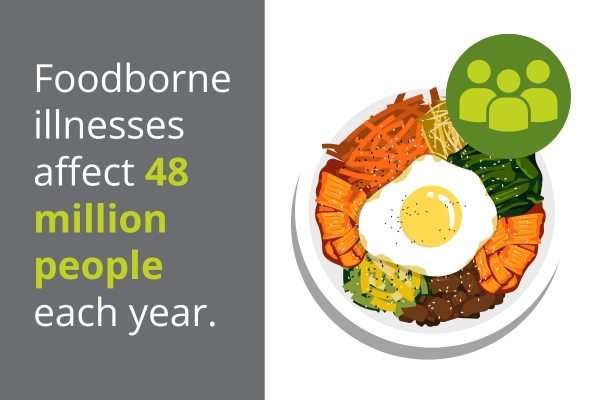January 22, 2025

Each year, foodborne illnesses affect 48 million people with contaminated foods being the primary cause. While anyone can be at risk, the good news is that these illnesses are largely preventable.
Understanding the common types of food contaminants and implementing proper food safety practices is essential for commercial kitchens to protect the health and safety of your customers. Health inspectors regularly evaluate kitchens to ensure compliance with food safety regulations, and failure to meet these standards can harm your restaurant’s reputation. By prioritizing food safety, you not only avoid potential violations but also demonstrate your commitment to high-quality service and customer well-being.

3 Main Biological Food Contaminants
Biological pathogens are a leading cause of foodborne illnesses and can easily go undetected due to their microscopic size. Understanding where these pathogens originate and the symptoms they cause is essential for preventing contamination and keeping your customers safe.
1. Bacteria
Bacteria are among the most common foodborne pathogens, and they thrive in environments where food is improperly handled or cooked. Certain types of bacteria are notorious for causing foodborne illnesses.
Bacteria can spread easily, especially in environments where food is improperly stored, cooked, or handled. Ensuring proper cooking temperatures, storage, and sanitation is essential to preventing bacterial contamination.
Common bacteria food contaminants: Salmonella, E.coli, Listeria
2. Viruses
Viruses are another significant cause of foodborne illness, and they can be easily transmitted through improper hygiene practices or contaminated food and water. Unlike bacteria, viruses do not need food to reproduce, but they can thrive in the body and cause illness.
Common virus food contaminants: Norovirus, Hepatitis A
3. Parasites
Parasites are organisms that live in or on another organism and depend on it for survival. In foodborne illnesses, parasites can cause serious health issues, and they are often found in undercooked or improperly handled animal products, including meat and seafood.
To prevent parasitic infections, it is essential to thoroughly cook meats to recommended temperatures and ensure that water used in food preparation is safe and clean.
Common parasite food contaminants: Giardia, Trichinella
3 Foodborne Illness Prevention Tips
Foodborne illness happens, but with a proper food safety plan and kitchen hygiene practices, it doesn't have to affect your establishment. Customers can contract foodborne illnesses in various ways. Taking a multi-pronged approach to combat exposure is essential. Here are three ways to keep your guests and employees safe:
1. Prioritize Kitchen Hygiene Practices
Physical and some biological contaminants are preventable through careful hygiene efforts. Proper hand washing throughout the food preparation process, after using the bathroom, and between tasks reduces biological contact risk.
Requiring gloves to cover bandages, trimming nails, pulling hair up and keeping it clean, and asking employees to remove jewelry before cooking prevents potential physical hazards.
2. Follow Food Safety Cooking Guidelines
When all ingredients are cooked and stored correctly, cases of salmonella, E. coli, and other biological elements can be avoided.
Stick to these FDA internal temperatures for safety:
- 165°F: Poultry and casseroles
- 160°F: Ground meats and poultry
- 145°F: Eggs, pork, fish and beef
When holding and storing food, prevent bacterial growth by avoiding the Danger Zone, which ranges from 40°F to140°F.
Maintain temperature logs to chart the internal temperatures of food upon delivery, during cooking, and cooling.
3. Create a Standard Kitchen Cleaning Protocol
Sanitization is key to preventing food contamination. Good practices include:
- Consistently sanitizing surfaces
- Washing utensils in between uses
- Keeping appliances clean
- Sanitize walk-in areas and refrigerators
- Check pest traps and change them as necessary.
Foodborne illness is avoidable. The key takeaways are always to monitor food preparation and storage, implement safety protocols, and develop cleaning schedules.
US Foods CHEF’STORE: Your Food Safety Partner
CHEF’STORE supplies the food service community with high-quality products and food safety tools. We’re here to help you implement your food safety plan, from bulk cleaning supplies to storage containers, fresh produce, and more!
Visit one of our nearby locations today.